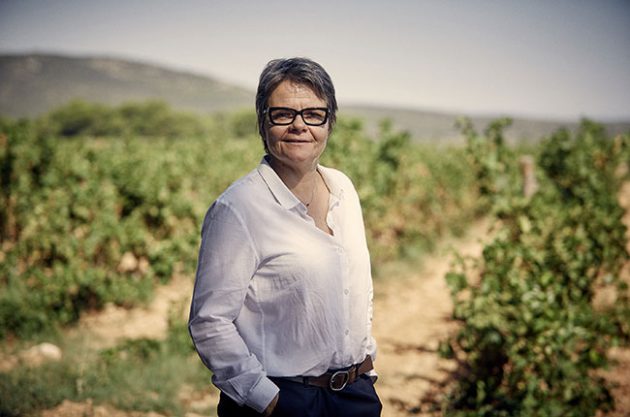Jefford on Monday: The advent of AdVini
Andrew Jefford talks to Brigitte Jeanjean about the rise of France’s fourth largest wine group, and tastes its Languedoc wines.
European wine production makes a challenging business prospect. The raw materials are an agricultural crop grown by widely scattered smallholders; quality and volume are at the mercy of the seasons. Wine’s an alcoholic drink subject to close and active governmental scrutiny, in part for health reasons but just as importantly for tax-raising ones. Quality at the highest levels, moreover, has always been predicated on difference, not consistency. All of these factors make brand building for European wine a complicated matter, which is why a business history of the wine world over the past few decades would be dominated by non-European entities such as Constellation Brands, Gallo and Treasury Wine Estates.
This is – slowly — changing. France’s privately owned Castel Group (built and run from Bordeaux by the formidable Pierre Castel) now claims to be the third largest international wine business, while the privately owned Grands Chais de France (built and run from Alsace by Joseph Helfrich) is France’s second largest privately owned wine company. The agricultural co-operative group InVivo (which already owns Cordier and Mestrezat, and which recently acquired UK distributor Armit via its purchase of the Dutch distributor Baarsma) is a major player not just in wine but in agriculture, animal nutrition and garden retail.
The group that interests me most, though, is the publically quoted AdVini, France’s fourth biggest presence. For two reasons.
The first is local. Improbably enough, the headquarters of this rapidly expanding international wine group is the little Languedoc village of St Félix de Lodez (population 1,054): dynamism where you might expect it least.
The second reason is that AdVini is trying to base its growth on quality wines above all (60 per cent of sales are AOP wine, with another 20 per cent being categorised as ‘terroir IGP’ wines). Castel’s success, by contrast, has been built on multiple factors (it is the biggest bulk buyer of Bordeaux and owns the French retail chain Nicolas, but it also has more vineyards of its own in Africa than in France — and has a quarter share of Africa’s beer market), while the rise to prominence of Grands Chais de France has been built on the famously wonky bottles of J.B.Chenet. Both are trying to make headway upmarket (Grands Chais de France owns Ch de Fesles and recently bought Mas Belles Eaux from AXA, while Castel has a half-share in Beychevelle), but neither flags quality wine as does the much smaller AdVini.
The company tends to be locally known by its former name of Jeanjean, and throughout most of the time since its founding in 1870, it has been a leading Languedoc négociant. Languedociens are not given to luxury, but they are very good at hanging on to what they have, and under Hugues and Bernard Jeanjean, company resources have been deployed in a canny acquisition and expansion programme since the mid-1990s. Ogier then Clos de l’Oratoire des Papes in Châteauneuf were the first non-Languedoc acquisitions, followed by Rigal in Cahors, Ch Gassier in Provence, Cazes in Roussillon, Antoine Moueix and more recently the Lapalu group of properties in Bordeaux (including the notable cru bourgeois Ch Patache d’Aux).
When Michel Laroche came to pass on his Chablis and Languedoc (Mas La Chevalière) interests in 2010, he chose Jeanjean ahead of other suitors including LVMH; the company then changed its name, and he worked with the newly baptised AdVini for several years afterwards. That acquisition also bought the Languedociens vineyards in Chile and South Africa (L’Avenir).

Domaine du Causse d’Arboras in Terrasses du Larzac, at the foot of Mont Baudile. Credit: AdVini.
Since then the Jeanjean family have acquired Clos des Paulilles in Collioure and Causse d’Arboras in Terrasses du Larzac, as well Champy in Beaune and the Pernand estate of Laleure-Piot. They’ve also acquired a majority stake in Ken Forrester’s interests in South Africa in addition to the Le Bonheur estate in Stellenbosch, all of which brings global vineyard holdings up to 2,775 ha. A new generation of Jeanjeans are now in charge (Brigitte, Frédéric and Philippe), working with CEO Antoine Leccia. The company structure means that Vignobles Jeanjean in Languedoc is just one unit along with the other wine-producing units, each of which is run independently.
I met up with Brigitte Jeanjean, the daughter of Bernard Jeanjean, earlier this summer to chat about its Languedoc vineyard division, where the company has seven estates and 190 ha planted altogether (with a 300 ha total in view), including the large old coastal property of Mas de Lunès in Grès de Montpellier (1,000 ha but only 40 ha planted), in family hands since the 1930s. She stressed the importance of vineyard ownership to the family – and said that they were always looking for good opportunities to expand the portfolio. That, indeed, had been the main motive behind taking the group public in 1994. In addition to properties in the schist zone of St Chinian (Domaine du Landeyran), in Faugères (Domaine de Fenouillet) and in Terrasses du Larzac (Causse d’Arboras), other zones they are exploring include Pic St Loup, Minervois and Corbières, and they already have a fermage (rental) agreement with an estate in the increasingly sought-after zone of Picpoul de Pinet.

Domaine du Landeyran in the schist section of St Chinian, near Roquebrun. Credit: AdVini.
I also had the chance to taste some of the Languedoc range with winemaker Matthieu Carliez up at Causse d’Arboras, a spectacularly high-sited, organically run 16-ha domain in Terrasses du Larzac underneath Mont St Baudile, at 320m. Carliez confided that the tastes of the Jeanjean family were for “supple, fresh, aromatic wines without too much tannin”, in contrast to the sometimes heavy, portentous style of many of Languedoc’s ambitious reds. “Aerial finesse and tension is what we are always looking for,” he continued. The coolness of the Causse d’Arboras site, where the Mourvèdre is usually November-picked, helps bring this here
A taste of the Jeanjean range
These are, in general, cleanly articulated, carefully crafted wines which offer a fair representation of their appellations, though they don’t come close yet to challenging the region’s leaders. How high might Jeanjean’s (and Advini’s) quality ambitions reach? Resources aren’t lacking, so it will be interesting to see what the next few years brings. Here are four of the best.
Viognier, Le Secret de Lunès, IGP Oc 2016
It’s hard to find poised IGP Viognier wines which show varietal style without glueyness or heaviness, but this fresh and floral example from the pebble-on-clay soils of Mas de Lunès works well. Spice, flowers, ginger – and nothing overdone. 89
320 Blanc, Causses d’Arboras, Languedoc 2014
There’s no oak used for this blend of limestone-grown Vermentino with 55 per cent each of Roussanne and Marsanne, just a light batonnage on fine lees in steel, and it’s all the better for that: pretty honey and almond scents and pear and apricot fruits with a little more almondy richness on the finish. Poised yet vinous. 89
La Faille, Causses d’Arboras, Terrasses du Larzac 2015
Two extraordinary recent faults leave the vineyards of Causse d’Arboras as a kind of upland promontory, soldered to the lower slopes of Mont Baudile. This blend of Syrah with 20 per cent Grenache and 10 per cent Mourvèdre has volume and drama: fresh plum fruits qualified by root spice and hints of juniper and cade. It’s lightly textured and discreetly oaked (just one third of the blend in demi-muids for 10 months). 90
MasoSchistes, Domaine Fenouillet, Faugères 2015
You first notice the attractive plum, prune and blackcurrant fruits in this blend of schist-grown, bush-vine Carignan with 30 per cent each of Grenache and Syrah. It’s only later that the stony residues in the wine’s allusive range become apparent, but they’re what give the wine its finishing sobriety and seriousness. 90

